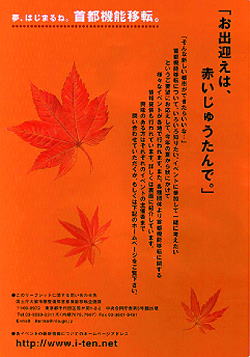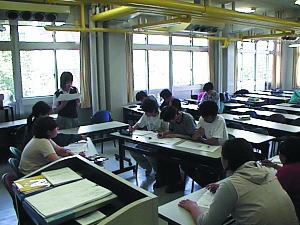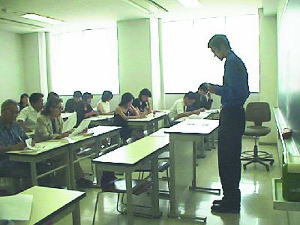| Status
of Contribution to the Opinion Exchange Spaces |
| (From August 20,1999 to August
20,2000) |
|
|
One year has passed since the National Land Agency Homepage
"Opinion Exchange Spaces" was established in
August 1999. Opinions contributed through the Homepage
so far are reported here. |
|
|
|
| 1.Numbers of Opinions Contributed
during the Year in the Past |
|
|
(1) |
Capital Functions Relocation Plaza (Opinion
Exchange Space for the Capital Functions Relocation
in General) 555 inputs |
|
|
|
|
(2) |
New City Plaza (Opinion Exchange Space for the
creation of a new city due to the Capital Functions
Relocation) 89 inputs |
|
|
|
|
Total: 644 |
|
|
|
|
| 2.Details of Opinions |
|
|
The opinions put forward by citizens can be
classified as follows. |
|
|
|
(1) Capital Functions
Relocation Plaza |
|
| 1)
29% |
2)
22% |
3)
19% |
4)
30% |
|
|
| 1) |
Opinions about the Significance and
Effects, as well as Approval or Disapproval
of the Relocation |
| 2) |
Opinions about the Relocation Site |
| 3) |
Opinions about Present Problems, Including
Environment, Transportation, and Administration,
in Japan |
| 4) |
Others |
|
|
|
|
(2) New City Plaza |
|
|
|
| 1) |
Opinions about Proposals for the New
City |
| 2) |
Opinions about New City Conditions |
| 3) |
Others |
|
|
|
|
|
| 3.Summary of Major Opinions |
|
|
|
Some of the opinions are summarized
and introduced below. |
|
|
|
(1) |
Both those who approve and disapprove of the
capital functions relocation agree that harmful
effects are caused by overcrowding and centralization
in Tokyo and some countermeasures are necessary.
The capital functions relocation will create a
good opportunity of reconsider major changes in
the urban planning of Tokyo. |
|
|
|
|
(2) |
Considering all of the hazards in Tokyo, the
capital functions relocation should be realized
by all means as a national strategy. |
|
|
|
|
(3) |
The capital functions relocation is certainly
a problem to be thought about by the youth of
today, particularly primary school and junior
high school students. Those who will be responsible
for the next generation ought to consider how
the nation should develop, and active discussions
in primary and junior high schools focusing on
the relocation as the learning material are sincerely
desired. |
|
|
|
|
(4) |
Social structure reform should not be the prime
objective in the capital functions relocation,
actions to be taken for further bettering the
country as a whole should be considered first. |
|
|
|
|
Proposals about the Diet Building,
urban layout, and others were also contributed
through images. |
|
|
|
Discussions among the nation's citizens
are essential to the capital functions relocation.
We would like people to continuously utilize the
opinion exchange spaces for contributing their
various opinions. |
|
|
|
| Capital
Functions Relocation from a Historical Point of View |
|
In Japan, the political centers have been relocated
in parallel with the state political reforms.
In this newsletter, the capital functions relocation
is looked on from a historical point of view.
"A Study of Miyako" by Professor Hidehiro
Sonoda of International Research Center for Japanese
Studies is also introduced. |
|
|
Historical Significance of the Capital Functions Relocation |
|
|
| Looking back over Japan's history, Japan
has reformed state political systems and
relocated its political center to create
a new governing system to respond to the
needs of the times. |
|
| In the past fifty years after the World
War , the domestic and foreign environments
around Japan have changed drastically,
and Japan is now approaching an significant
turning point in anticipation of a new
era. |
|
| To establish a new era, it is necessary
to reconsider the current institutions,
which were established since the Meiji
Era, and look forwards Japan's future. |
|
| The capital functions relocation is
a very important issue deeply related
to Japan's future, and it will control
future outcome of state politics. It is
a major historical project that should
be considered from a long-term view point
well beyond the next century. |
|
|
| *Major Era Transitions in Japan |
|
| Years
of Grace |
Era
Transitions |
Reasons
for Relocation and Selection |
| 710 |
Heijo
Era Capital
(Nara) |
| Establishment
of a Statute System |
| To Prevent
Disaster Caused by Starvation
and Epidemics and to Pray
for Good Fortune |
|
| 794 |
Heian
Era Capital
(Kyoto) |
| Separation
from Buddhist Power |
| Convenience
of Land and Water Transportation |
| To Renew
People's Minds |
|
| 1192 |
Kamakura
Shogunate
(Kamakura) |
| Rise
of Samurai Power |
| Independence
from Court Noble Power |
| Place
Connected to the Genji
Clan |
|
| 1338 |
Muromachi
Shogunate
(Kyoto) |
| Utilization
of Traditional Authority |
|
| 1603 |
Edo
Shogunate
(Tokyo) |
| Establishment
of Samurai Power |
| Development
of the Kanto Plain |
|
| 1868 |
Meiji
Government
(Tokyo) |
| Utilization
of a Large City, Tokyo |
| Geographical
Position |
|
|
| * |
Reasons for relocation
or selection includes those whichare not
completely accepted opinions. |
| The
Source: |
Prepared by
the Metropolitan Areas Development
Bureau of the National Land Agency
based on information from various
sources. |
|
|
|
|
|
|
|
| "A
Study of Miyako" |
|
| Professor of International Research
Center for Japanese Studies |
| (Specializing in the Social History
Research Theme: Comparative Research of
Social Change History) |
|
|
|
|
|
Miyako is a compound conception
consisting of three elements: (1) suitability
for the seat of the Emperor's Palace; (2) suitability
for the Capital; and (3) suitability for a city.
(For detail, refer to "Universe Called 'Miyako,'"
NHK Books, 1994.)
(1) With regard to the suitability for the seat
of the Emperor's Palace, "Miyako" originally
means the place where the Emperor lives, based
on the fact that "Miyako" is written
in Japanese as "the Emperor's Place."
(2) With regard to the suitability for the Capital,
"Miyako" implies that it plays a role
as the political core (the seat of public authority)
because Emperors in ancient times were political
men of power.
(3) With regard to the suitability for a city,
there is a major premise that "Miyako"
is a large city. However, Miyako originally was
not suitable for a city but was made suitable
later as Kyoto (Heian Era Capital) underwent changes.
It is said that the Heian Era Capital had a population
of about 70 to 80 thousand when it was constructed.
Thereafter, as time passed, the population increased
in parallel with the development of the Heian
Era Capital, and Miyako gained the element of
suitability for a city.
However, more importantly, it is interesting to
note that Miyako does not necessarily need to
possess these three elements.
In Japan for example, during the Genroku period
in the seventeenth century, Miyako is clearly
recognized to be Kyoto, even though it was certain
that the "seat of public authority"
was Edo. In other words, if we try to specify
the capital in the Edo Era from the viewpoint
of a capital as conceived in the modern West,
Edo is unmistakably the only one, but Edo was
not Miyako.
Though the remark "Kyoto was a millenary
capital" is frequently heard, it does not
mean that Kyoto was the capital of Japan for a
thousand years. In the first place, the concept
of the "capital" separated from "Miyako"
had not existed before the Meiji Era, as stated
before. There seems to be a common stereotyped
understanding that Tokyo became the "capital"
when the capital was transferred to Tokyo. If
so, this ends up in the paradox that Kyoto had
been the capital before that time.
In my opinion, Tokyo has not been the "capital"
but the "Miyako," that possesses all
of these three elements described at the beginning
of this paper, from the Meiji Era to the present,
(See "Is Tokyo the Capital?," the Edo
Tokyo Museum Symposium Report 2, 1999.) It can
be said that only Kyoto in the latter part of
the Heian Era and modern Tokyo were and are the
perfect Miyako (meaning to possess all three essential
elements).
We can also say that the capital functions relocation
now under discussion is a trial to once again
separate the three elements possessed by Miyako. |
|
|
|
| Joint
Public Relations Activities|Posters
and Leaflets Renewed |
|
| The start of the project "Joint
Public Relations Activity with Participation
of Various Organizations and Local Public
Bodies" under the catch phrase "Dream
Initiated! Capital Functions Relocation!"
was introduced in the New Era vol. 14.
We greatly appreciate the participation
of many people in the various events held
in each region. |
|
| The poster in the renewed design has
underlying tones of "scarlet maple"
and orange to suggest the image of autumn.
The "red carpet" in the poster
indicates both the "carpet"
in the Diet building and the "carpet"
metaphorically expressing tinted maple
leaves lying thickly on the ground in
the country hills or gardens. |
|
| Various events related to the capital
functions relocation, including the details
and additions to the events introduced
by the previous posters are introduced.
This up-to-date information is also introduced
on the Homepage.
Please visit this site; We are hoping
many people will participate. |
|
 |
|
|
| TOPIC |
Capital Functions Relocation Discussed
at Various Schools and Other Institutions |
|
|
|
Bosei
High School Attached to Tokai University |
|
| On July 14, the
freshmen of the Bosei High School
attached to Tokai University held
a debate on the theme of the capital
functions relocation as part of
the class on the "Theory
of Modern Culture." They
were divided into supporting and
objecting groups and various discussions
were actively developed between
the two groups from viewpoints
of the significance and effects
of the relocation. |
 |
|
|
|
|
Economics
Department of Toyo University |
|
| On July 22, sophomores
of the Matsubara Seminar of the
Economics Department, Toyo University,
took up the capital functions
relocation as the debate theme
as part of their debate class
and participated in a hot discussions
on the pros and cons of the relocation.
Because careful preparations were
made, plenty of arguments from
both sides were developed in spite
of the time limit of several minutes
for one step for each side in
the process of arguments, questions,
answers, responses, and conclusions. |
 |
|
|
|
|
Explanation
about the Capital Functions Relocation
on the "Children's Kasumigaseki Visitation
Day" |
|
The "Children's
Visitation Day" was held
on August 23, the National Land
Agency, and seventeen children
from three to thirteen years of
age participated together with
their parents.
During the event, a National Land
Agency official explained about
the capital functions relocation
using a video display and brochures
specially prepared for children
and let them experience a virtual
capital function city by operating
a personal computer using the
"Capital
Function City Experience CD-ROM."
Children and parents asked serious
questions, and they enjoyed operating
personal computers. We believe
they must have had quite a different
summer vacation day. |
|
|
|
|
|
|
Accessing Various Information |
|
Various information concerning the capital functions
relocation has been being provided on the National
Land Agency Homepage on the Internet.
Also if you are interested in items described
in this leaflet and others, please let us know.
We will pleasingly send related documents to you.
We are awaiting your contact. |
|
|
| We
are Waiting for Your Contact |
|
Address: Capital Functions Relocation Planning
Division, Metropolitan Areas Development Bureau,
National Land Agency
2-2 Kasumigaseki 1-Chome, Chiyoda-ku, Tokyo 100-9972
JAPAN
Homepage: http://www.mlit.go.jp/kokudokeikaku/iten/index.html
E-mail:hqt-itenka(a)gxb.mlit.go.jp (Please replace (a) with @)
|
|
|
|